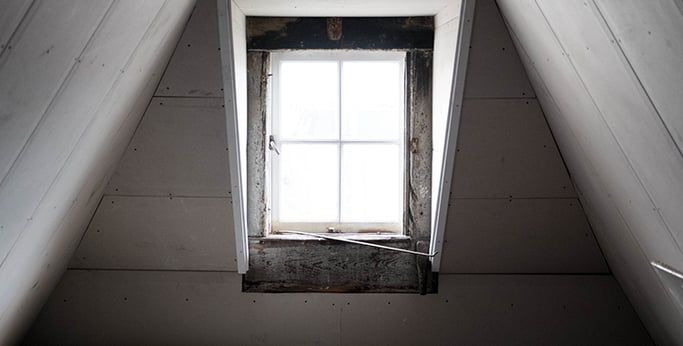
Finding water damage on walls or ceilings is worrying for any homeowner. Most may assume this is caused by a leaking roof, but that might not be the source. During winter months, water found in these places is commonly caused by condensation in the attic. Fixing this issue can be less costly than replacing a roof, but it should be addressed as soon as possible. This is especially common during harsh Iowa winters, like the ones we’ve had in 2023 and 2024.
What Causes Water Condensation?
During extremely cold weather, frost accumulates in your attic. When warm air from your heated home rises and seeps into the attic space, that frost melts and creates condensation that can damage your home.
So, My Roof Isn’t Leaking?
Knowing how to spot the warning signs of a roof leak can help you distinguish one from condensation. Inspect the ceiling on the inside of your home for bubbled paint, dark water stains, dripping water, or a musty smell. Then, once you're done with the inside of your home, head outside to check areas commonly prone to leaks, like roof valleys, the chimney, windows or skylights, and damaged shingles. Also check to see if your roof is sagging or if there is noticeable algae growth on the shadier areas. In winter months, ice dams or frost in your attic can also mislead homeowners into thinking it’s a roof leak. If the ceiling damage seems to appear after a cold snap, attic condensation is a strong possibility.
Condensation can cause mold and poor air quality and can lead to ceiling collapse, so it should be inspected immediately. At Hedrick Construction, we help Central Iowa homeowners quickly identify whether it’s a roof problem or a condensation issue, and we’ll recommend the most cost-effective solution—whether that’s ventilation, insulation, or roofing help.
Steps to Address Water Condensation
In addition to heating your home, daily routines like cooking over the stove or taking a hot shower also create condensation. Cultivating some simple habits will help reduce the impact of these tasks. If taking the steps below doesn't solve your condensation problems, they may be due to poor ventilation or insufficient insulation.
Task One: Open All Air Vents
It's a common misconception that you closing air vents in unused rooms is a good way to save money. In fact, however, decreasing air circulation can actually damage your HVAC system and compromise your ventilation, resulting in condensation. Especially in Iowa homes built before 2010, HVAC systems may not circulate air evenly—leading to frost buildup in attic corners during subzero temperatures. Open all vents, and make sure they are working properly to ensure this isn’t the source of the moisture issue.
Task Two: Utilize Your Bathroom and Kitchen Exhaust Fans
It seems like a small step, but exhaust fans are an essential part of reducing humid air that can leak into other areas of your home. Run the exhaust fans whenever you’re cooking or taking a bath or shower. In bathrooms, best practice is to run the fan for 30–60 minutes to return humidity levels back to normal. In older Des Moines and Ankeny homes, exhaust fan ductwork may be improperly routed into the attic instead of outside. That funnels warm moist air directly where condensation forms.
Task Three: Reduce the Use of Your Humidifier
Many people run humidifiers in their home during the winter if they feel the air is dry. While this is fine on occasion, overuse can create excess humidity, resulting in condensation. If you find find condensation on your windows, this could be an early indication that your humidifier is the source. Learn more from our previous post about using humidifiers in your home.
Task Four: Inspect Your Attic Insulation
If you have taken the proper steps to remove excess humid air from your home, and you're still having condensation issues, it might be time to check the attic insulation. Insulation is responsible for keeping warm air inside your living space and out of the attic, where it can lead to condensation. Our team can inspect your attic and recommend blown-in insulation, air sealing, or ventilation upgrades that prevent this problem long-term—especially before next winter.
Task Five: Check Your Ventilation System
Poor ventilation causes a lot of issues for homeowners. Your ventilation system should extract warm air from the attic and replace it with cool, dry air via a soffit. If the system is working properly, it will prevent moisture and mold. This not only will help to solve condensation issues but also improve air quality and make your home more energy efficient.
If you're seeing water spots this winter, don’t panic—it may not be your roof! Contact Hedrick Construction for a free attic inspection in Ames, Ankeny, and surrounding areas. We’ll find the source, fix it right, and help you avoid expensive repairs down the line.







Comments